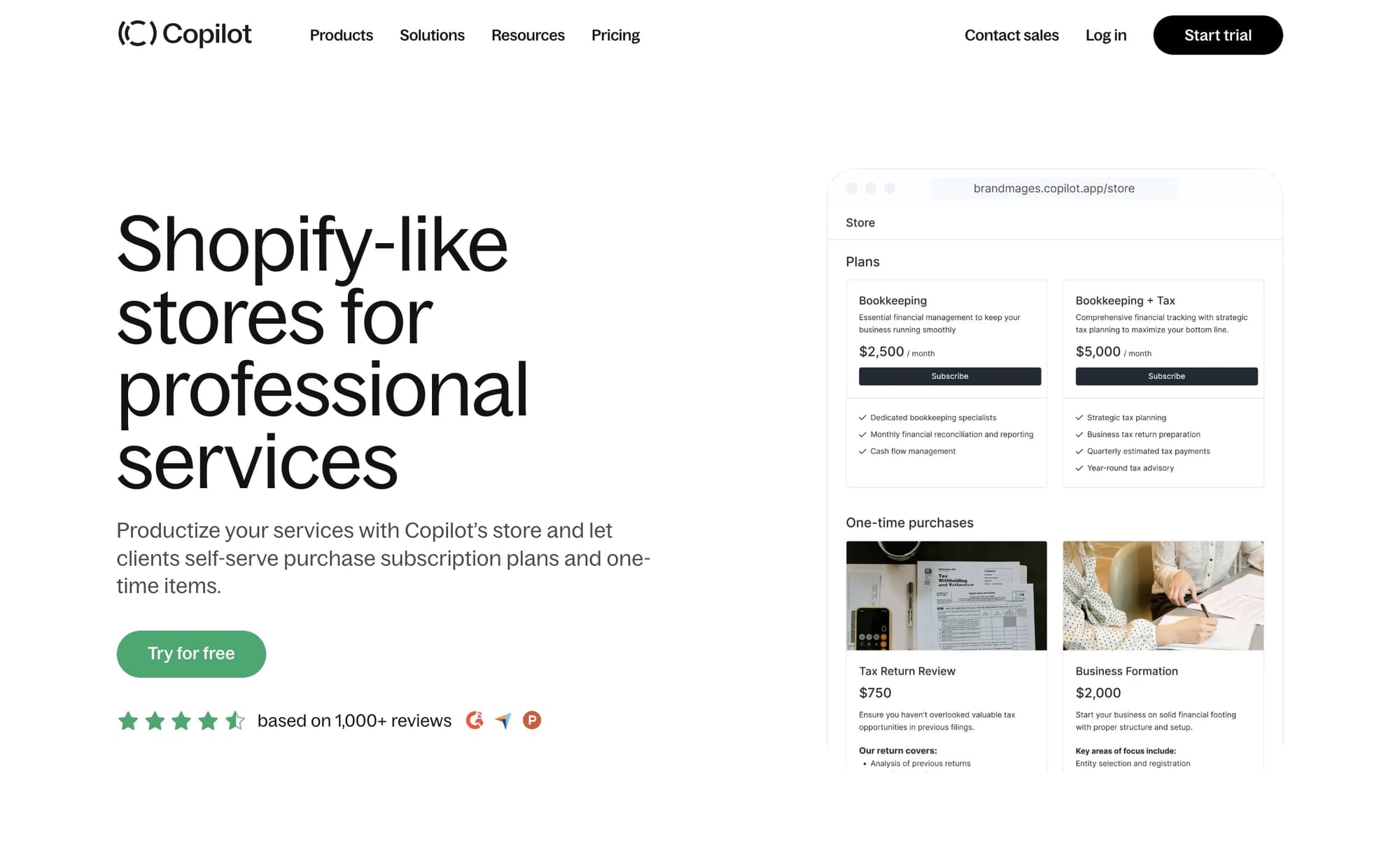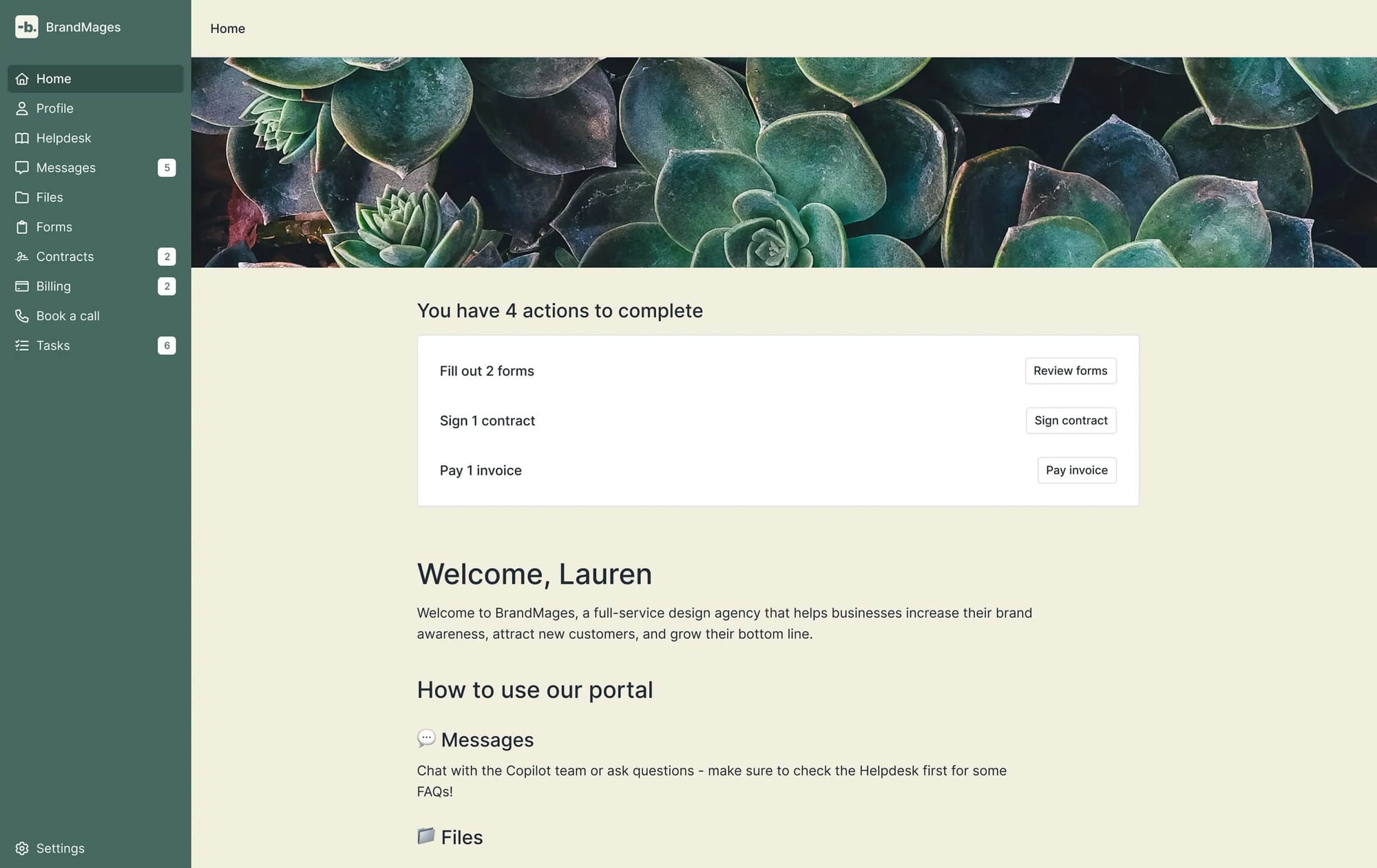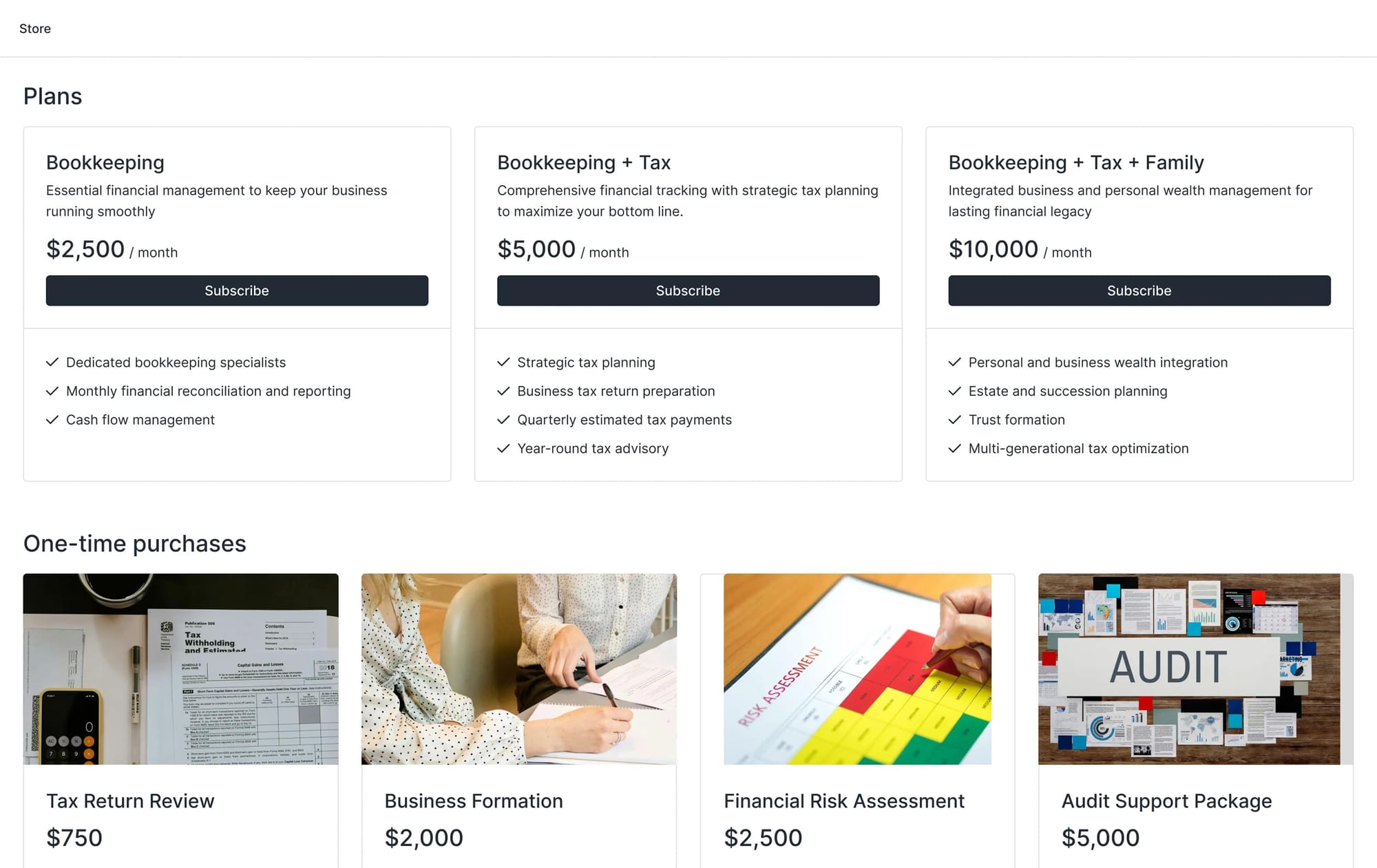Shopify for service businesses: How to run a top agency
Looking for the Shopify for service businesses? In this article, I'll show you how to run your service business like an Shopify ecommerce store.

Shopify is one of the most well-known ecommerce platforms today.
In fact, the brand has become synonymous with selling physical products online. And it’s with good reason. Shopify gives ecommerce business owners all the tools they need to get their website up, handle shipping, accept payments, and view their analytics.
On top of that, there’s a huge Shopify plugin marketplace that allows you to expand your store's functionality so you can add things like email marketing, different shipping methods, and a ton of marketing tools to help you grow your brand and get more customers.
So why hasn’t anything like this existed for service providers, freelancers, or agencies?
Well, there actually is a solution. In fact, there are a few software tools that are essentially the Shopify for service businesses.
And in this article, I want to show you how I’ve personally been able to create my own content marketing agencies that feel like a Shopify store, with all the management and payment tools.
Let’s get into it.
Is Shopify good for service businesses?
While some people find ways to make Shopify work for service businesses, it’s not designed for it. It’s not the best platform when it comes to running a service business or agency.
The thing is, Shopify was built from day one for physical products. Every single feature assumes you're shipping something that can be held. The entire checkout flow, the inventory management, and the fulfillment options all revolve around getting a physical product from point A to point B.
But services are different. When someone buys a marketing package from you, they're not waiting for a delivery. They need access to communicate with you, share files, track progress, and actually work together right away. Shopify just... doesn't do that.
I've watched so many agencies try to force it to work. They'll use Shopify for the transaction, then immediately email the client saying "Okay, now let's move over to Slack for communication, and I'll send you a Dropbox link for files, and we'll use Calendly for meetings." It's all duct-taped together, and it comes off as more scattered and less polished.
The recurring billing situation is even worse. Sure, Shopify has subscription apps, but they're built for subscription boxes and product deliveries, not ongoing services. Try explaining to a client why their "subscription" shows up as a physical product order every month. It's awkward.
And don't even get me started on what happens after the sale. With ecommerce, the journey ends at checkout. With services, that's where the real work begins. Where do clients go to message you? How do they access their deliverables? Where do they sign contracts or fill out onboarding forms? Shopify currently has no answer for any of this.
Can I sell services through Shopify?
If you do a Google search for “Shopify for service businesses,” you might come across this page from Shopify titled “How to start a Services business with Shopify”. At first glance, it feels like Shopify actually has a solution for service businesses.
But when you click into it, you see it’s actually not a guide. But rather, it’s a collection of a few case studies. Which, quite frankly, aren’t full-service businesses. They appear to be businesses that sell physical products but have found a workaround to sell services as an add-on to their customers.
And to be honest, it’s not ideal. There are no real examples of companies like marketing agencies, accounting firms, or service providers that only sell services or digital products.
But I’m going to show you how to sell services using all the benefits of an ecommerce brand without needing to use Shopify.
How to sell your agency's services like an ecommerce brand
Here are five steps to selling your services like an ecom brand:
- Find a platform that is made specifically for service businesses
- Productized your services into packages
- Set up a self-serve storefront where clients can buy
- Automate your onboarding
- Use recurring billing to build predictable revenue
Let’s go over each in depth.
1. Find a platform that is made specifically for service businesses

Just like Shopify, and other tools like WooCommerce that exist for running ecommerce businesses, there are a handful of different tools for running service businesses.
These tools can range anywhere from simple invoicing tools for freelancers like Bonsai, to tools for growing agencies like Assembly, to enterprise-level solutions for vendors like Moxo.
What service businesses really need is their own "Shopify" — something that's powerful enough to scale but simple enough to use from day one.
After trying pretty much everything out there (trust me, I've been through the tool-hopping phase), I landed on Assembly. And I'm not just saying that because this is on the Assembly blog. I'm actually a customer who's been using the platform for 2.5 years now for my own content marketing agency.
Some of the features of Assembly I love:
- Built for growth: Start with one client, scale to hundreds without switching platforms.
- Flexible monetization: With the new Store feature, I can sell monthly retainers, one-off consulting projects, or even ad spots for my newsletter — all through one platform.
- Actually designed for services: Unlike trying to hack Shopify to work for services, everything here makes sense for how agencies actually work.

The features that sold me:
- White-label client portal (your clients will think YOU built this)
- Automated invoicing and subscriptions
- Integrates with the tools I already use (Airtable, Zapier, you name it)
- Compatible with my existing workflows — I can keep my existing processes.
But the real selling point is the client experience it provides. It actually makes you look more professional. Instead of sending clients to five different tools, they get one login that has everything.
So, first step, find a client portal platform that has some sort of store or productized service selling feature. In this case, I’m going to go with Assembly.
2. Productize your services into packages
If you're still sending custom quotes for every single prospect, you're making life harder than it needs to be. Trust me, I've been there. Spending hours crafting proposals that may or may not close.
If there’s anything I’ve learned about making a (fruitful) full-time income from freelance or agency work, it’s to stop selling your time and start selling outcomes.
Think about it, when you buy something on Shopify, you know exactly what you're getting and how much it costs. No more "let me get back to you with a quote." No three discovery calls. Just clear options with easy-to-understand pricing.
Here's an example of how to package your services like products:
Start with three tiers (people love options, but not too many):
- Starter: Your entry-level package for smaller clients
- Growth: Your sweet spot — most clients should land here
- Scale: Premium offering for larger clients (the ones with the big $$$)
For my content agency, that looks like:
- Starter: 4 blog posts/month for $5,000
- Growth: 8 blog posts/month + SEO optimization for $9,000
- Scale: 12 blog posts/month + SEO + promotion through my media business for $15,000
See how clear that is? No hourly rates. No "it depends." Just simple packages that clients can actually understand.
The magic happens when you build your productized service business model around recurring revenue instead of one-off projects. Instead of constantly hunting for new clients, you're building predictable monthly income. And the average lifetime value (LTV) per client can go well into the six figures (if you’re actually driving measurable growth).
Not sure what to package? Check out these productized service examples from different industries. The key is finding that sweet spot between what clients actually want and what you can deliver consistently.
Once you figure out your packages, you need somewhere to sell them. That's where having an actual storefront comes in clutch — but we'll get to that next.
3. Set up a self-serve storefront where clients can buy
Remember the last time you wanted to buy something late at night just to feel something? You probably just went on Amazon or a brand built on Shopify and bought it. But when a potential client wants to hire your agency at 11 PM, they have to fill out a contact form and wait for you to get back to them.
That's where having a self-serve storefront changes everything.

With Assembly's Store feature, you can literally create your own Shopify-style storefront for your services. Clients can browse your packages, pick what they need, and pay — all without a single email from you.
Here's how to get it running:
First, sign up for Assembly to set up your own customer portal. I'd recommend checking out their demo portal first (embedded below) to see how everything works. It's pretty cool to click around and see what your clients would experience.
Next, customize everything to match your brand. This is where it gets fun. You can start with a pre-built template, or you can fully customize it. Here’s what you can customize:
- Your logo and brand colors
- Fonts and styling
- Which apps and features clients see
- Even the URL (like portal.youragency.com)
The cool part is that after someone purchases from your store, they don't just get a "thanks for your order" email and disappear. You can set it up so they automatically taken to their own client portal where they can:
- Message you directly (no more email chains)
- Sign contracts without printing anything
- Access their invoices and payment history
- See project updates in real-time
Setting up payments is stupid simple. Assembly handles all payments through Stripe, so you get that professional reliability. But here's what's different from creating regular Stripe payment links — everything happens inside your branded portal. Your clients never see Stripe's interface. They just see your brand. It makes you look like you have your own professional payment gateway.
You can accept:
- Credit cards
- ACH transfers (for those bigger clients)
- Recurring subscriptions (my favorite)
And yes, you can add clients manually if someone wants the old-school experience. But trust me, once you see how smooth the self-serve flow is, you'll want everyone going through your store.
The whole setup takes max an hour. Compare that to trying to hack together Shopify for services or building something custom, it's a no-brainer.
4. Automate your onboarding
If you're doing it manually every single time, you're basically burning money. I used to spend hours on each new client. Sending welcome emails, creating folders, assigning tasks, and setting up Slack channels. It was exhausting.
Now? My clients get a better experience, and it’s cut my onboarding flow by more than half.
When someone buys from your store, that should trigger a whole sequence of events automatically. Think of it like a domino effect. One action sets off a chain reaction that gets your client perfectly set up without you touching anything.
Here's what my automated onboarding looks like:
Client purchases → Instant magic happens:
- Welcome email goes out with their portal login
- Onboarding form gets assigned to them
- Contract is ready for e-signature
- Their first invoice is generated
- My team gets notified in Slack
All of this happens in about 30 seconds. Meanwhile, I could be at the beach (though let's be real, I'm probably just working on other stuff).
With Assembly's automation features, you can build these workflows without any coding. It's like Zapier, but built right into your client portal. You just pick your triggers (like "new client created" or "payment received") and choose what happens next.
Some automation ideas that changed my life:
- Send different onboarding forms based on which service they bought
- Automatically assign team members based on the client's package
- Create recurring tasks for monthly deliverables
- Send a personal welcome video message after signup
- Trigger a feedback form
Your clients will think you're incredibly organized and on top of everything. They have no idea it's all automated. They just know that working with you feels smooth and professional from the first minute.
Remember that every manual task you do repeatedly is stealing time from actually growing your business. Set it up once, let it run forever. That’s why we have AI now. Use it.
5. Use recurring billing to build predictable revenue
Want to know the difference between agencies that scale and ones that struggle? Two words: recurring revenue.
When I first started, I was constantly chasing the next project. Finish one website build, do an annual content strategy package, or complete a marketing audit for another. Constantly scrambling for the next client. I questioned why I even quit my 9-5 for this path. It was exhausting, and my income looked like a roller coaster.
But when you combine productized services with recurring billing? That's when the magic happens.
Think about it. Your favorite SaaS tool doesn't re-sell you every month. Neither should you. Your clients should wake up on the 1st knowing they're getting value from you, and you should wake up knowing exactly how much revenue is coming in.
With Assembly's invoicing system, you can create subscriptions that recur on whatever schedule makes sense:
- Monthly retainers (my bread and butter)
- Quarterly strategy sessions
- Annual packages with a discount
- Even weekly check-ins for high-touch clients
The Store feature handles all of this automatically. Set it up once, and payments just... happen. No awkward reminders. No chasing down invoices. Just predictable cash flow.
But here's where it gets really interesting — one-off upsells.
Your recurring services are your foundation, but the Store also lets you add one-time purchases that boost your client lifetime value. These are perfect for those "while we're at it" moments.
Some examples of one-off upsells that work great:
- Extra content pieces: Client on the 4-post plan needs 2 more this month? Boom, one-click purchase
- Backlink mentions: Sell spots on your personal blog for $500 (clients love the SEO juice)
- Social media shoutouts: Promote their launch on your LinkedIn or Twitter
- Strategy deep-dives: 2-hour recorded session analyzing their competitors
- Rush delivery: Need that content in 48 hours? That's a premium add-on
- Annual audits: Comprehensive reviews of their marketing performance
Note that these examples are from a marketing agency perspective, which is what I know most. But Assembly’s customers range everywhere from marketing agencies to accounting firms to law firms and tech startups.
The beauty with these recurring payments through the Store is that existing clients can just pop into their portal and grab these extras whenever they need them. No proposals. No back-and-forth. Just instant value delivery.
Here's an example setup: Most clients are on a $9,000/month retainer, but the average client actually pays $9,800/month thanks to these add-ons. That extra $800 per client adds up fast.
If you're new to billing clients, check out this guide on how to bill a client for the first time. But honestly, once you have recurring billing set up, you'll never want to go back to project-based work.
Stop trading your time for money. Start building an actual business.
Assembly: The Shopify for service businesses
When you're running a service business, it feels like you're context-switching between a million things at once. Client communication, project management, invoicing, contracts, and more. And that's all before you even do the actual work (which is where most of your energy should be put towards).
That's exactly why I started looking for the "Shopify for services" in the first place. I wanted something that would let me run my agency like a real business, not just a glorified freelance operation.
After 2.5 years of using Assembly (and trying pretty much every other option out there), I can confidently say this is it. This is the platform that lets service businesses operate like product companies.
Here's what makes Assembly the Shopify of services:
Just like Shopify revolutionized ecommerce by making it easy to sell products online, Assembly does the same for services. You get:
- A real storefront where clients can browse and buy (not just a contact form)
- Automated everything, from onboarding to billing to follow-ups
- Professional infrastructure without the enterprise price tag
- Flexibility to grow, works whether you have 1 client or 1,000
But here's what really sealed the deal for me was the client experience I could provide. It actually makes you look good. When clients see your portal, browse your services, and experience that smooth onboarding, they know you have your stuff together. They trust you more. They stick around longer. They buy more. That’s how you create a business that unlocks a completely new life for you and your loved ones.
Here’s to scaling our service businesses!

